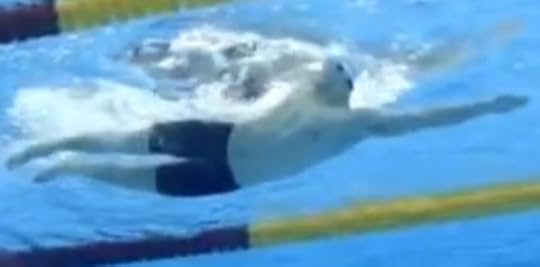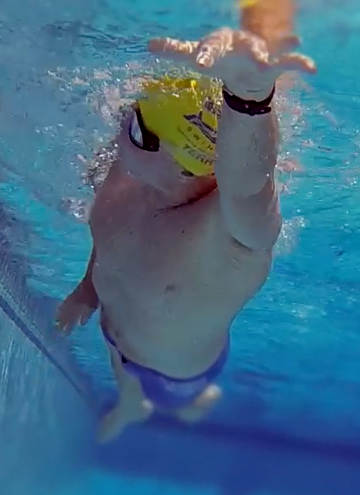Terry Laughlin's Blog, page 23
August 13, 2014
Back in the Channel
This week, if the good old English weather allows, I will be taking part in a relay of the English Channel. So far the weather isn’t looking great! As I am writing this, it is very dark, wet and miserable at 9am on the morning of the first day of our window. I suspect the coaches from LA are not impressed with England today!!! 
Our relay team is made up of 6 TI coaches, hence the name TI 6. I am from the UK and all the other coaches are from America. The relay is being arranged by one of the TI coaches, David Cameron, who is very experienced in the Channel. Dave has already completed two solos of the Channel and many relays, he is our guru. I met the other coaches whilst at an open water camp, workshops or doing training myself in America and part of the opportunity for me, as well as the swimming of course, is to spend time with a group of people I really like and who know lots and lots about swimming.
Amongst my friends and students it is no secret that I plan to swim the Channel solo over the next couple of years and so some people are probably wondering why a relay at this point in time……
For me this trip will be a very personal journey as last year I was with my friend Susan Taylor when she lost her life trying to swim the channel for charity. Susan had been a successful swimmer for the local club as a youngster and I met her when we were teenagers lifeguarding at the local pool. After lifeguarding she had gone off to qualify as an accountant and I met up with her again when she increased her swimming as part of a challenge for charity. Although I wasn’t Susan’s coach, as she was working with a lovely guy who used to be her swim club coach, she and I would often chat over her technique in the pool and I would help her when I had some spare time in between sessions. We’d chat about the challenge and often spoke about me possibly doing the same swim at some point. She asked me to go along on the boat to be her support swimmer as she wanted someone to swim with her some of the way. Susan swam really well and was really close to the shores of France when she suddenly passed away. Instinct naturally cut in when I dived in for Susan fully clothed but I had never been in that position before and definitely not with a friend and to be honest I do not remember much.
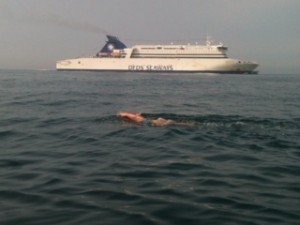
Susan swimming in the Channel
After Susan’s death everything was a bit of a blur for a while and I cannot possibly imagine the pain her family had to through and still go through. One thing I do remember clearly though was that I had made a promise to my daughter. I was due to swim the strait of Gibralter, a swim from Gibralter to Morocco, with Terry Laughlin, Lennart and Tommi, not many weeks after Susan’s death and my daughter was beside herself about me swimming. Whilst still in France that day I had, through tears on both ends of the phone, promised my daughter I would not do that swim or the channel, as she was hysterical, but I had made sure I only said that I wouldn’t do it that year because I didn’t want to ever break a promise to her and I knew I couldn’t go forever with just swimming in a pool and not trying the bigger swims that I want to do.
I pulled out of the Gibralter swim once I was back, exactly as I had promised, but 6 days later got up at 4am in the morning and travelled down to the South of England and did a short 3km sea swim without telling anyone except fellow TI coaches Dawn and Gill from Essex who were there to support me. I thought it was better to get straight back in the water and swimming felt as good as it always had, I’d got over the first hurdle.
One of the other things that stuck in my memory, as well as my daughter Susie’s reaction, was Susan’s family and especially her dad’s reaction. He told me she would want me to carry on swimming because she had loved to swim and she wouldn’t want anyone to stop. Susan had been motivated and gave everything to her swimming. I knew I still wanted to swim and if I’m going to do the channel I need to not only build up to it on a fitness front, but I need to build my family’s confidence to make sure they can feel comfortable with me doing it. So 2014 has been a year of swimming so far for me, with Susan being behind much of my motivation.
I have been swimming outside most days and doing drills in the pool. I have been setting myself small targets and bigger challenges as I tend to find that is what motivates me. So I have booked events and swam in different parts of the country with different people. And swimming still makes me very happy!
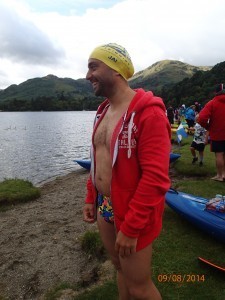
Coach Jai getting ready to swim Ullswater in the Lake District, UK.
I’ve proved to myself that my confidence in open water has not been affected, but I’ve not been back in the Channel and that holds more significance – it is a bigger challenge than just swimming. I don’t remember much of the trip back last year, but I haven’t been back to Dover since returning on the boat and I won’t lie that it will be with mixed emotion that I return. I think even the drive down will be challenging emotionally.
So that is why the relay is so important to me. As well as getting to spend time with the team, I will be with five friends and fellow coaches that will be a great support when I go back in that particular water. It is also another step in the journey to build my family’s confidence so I can swim the channel solo one day with a clear conscience that they will feel OK about it, as I really feel I can’t do it until they are ready.
So it is a big thank you from me to the rest of the team, Coaches Rachel, Mandy, Stuart and Todd and especially big coach Dave Cameron for giving me the opportunity of getting back in the Channel with fantastic support and friendship to get me through it. Here is to hopefully reaching the shores of France and picking up some pebbles in memory of Susan.
Coach Jai – Midlands UK
Swimjai@me.com
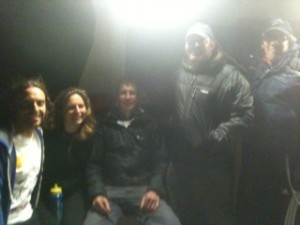
Susan before setting off in the Channel
The post Back in the Channel appeared first on Total Immersion.
August 12, 2014
Why Swimming Can Be More Beautiful Than Golf
At the recent PGA Championship—one of golf’s four major championships—Tom Watson came within two strokes of making the cut to play to two final days. He did this less than a month shy of his 65th birthday.
Watson, who was the top ranked player in the world for 5 consecutive years in the late 70s and early 80s, won 8 majors, including the British Open five times. He nearly won it a sixth time two months short of his 60th birthday, leading the field by one stroke as he went to the 72nd hole, then losing by a stroke in a playoff to Stewart Cink.
That a player well into middle age can still compete on even terms with players four decades his junior testifies to the fact that golf is still primarily a game of skill—though Watson’s drives today fall nearly 100 yards shy of those of Rory McIlroy, the 25 year old from Northern Ireland who has so thoroughly dominated world golf this summer. Watson compensates with accuracy on approaches and finesse around the greens.
Interviewed on the NPR news show All Things Considered a day after the PGA Championship (the only major that eluded him), Watson said the following:
“The beautiful thing about golf is that you take a ball that’s 1.68 inches in diameter and you hit it with a club which is ill-designed to project a golf ball, and you can make that ball travel 200 yards and end up 6 inches from the flagstick.”
And as many golfers know, the other beautiful thing about golf is that amateurs and even duffers can regularly—and not unrealistically–dream of hitting such a shot. Even well into middle age.
While it’s inconceivable such persons might hit a baseball over the wall in a professional ballpark, or dunk a basketball, or kick a 40-yard field goal—they can and do entertain the possibility of hitting a golf shot that would make a touring pro smile. What an uplifting sense of possibility.
The even greater beauty of swimming is that a swimmer of any age can achieve fluent form as good as that of the current world record holder.
And not just once in a while, but stroke after stroke after stroke.
For illustration here’s a screen shot from youtube of Sun Yang breathing during his 1500m world record swim last year.
And one of a certain 63 year old TI coach and swimmer from video shot last week.
The post Why Swimming Can Be More Beautiful Than Golf appeared first on Swim For Life.
The post Why Swimming Can Be More Beautiful Than Golf appeared first on Total Immersion.
August 7, 2014
TI6 – Total Immersion 6 – 6 Total Immersion Coaches English Channel Relay
We are not out to set a new record like the Total Immersion officially sponsored “EC6-Total Immersion in the English Channel” relay team that consisted of six of the top 40-50 year old swimmers in the world trying to break the relay record from 1990 set by a team comprised of 20 somethings. They swam on August 5th, 2014 and missed setting a new record by a mere 11 minutes–an awesome and inspiring performance by this EC6. We are simply out to do the best that we can do. Our training regimen has not been as rigorous as the EC6 but we will succeed in our challenge due to the strength of our Total Immersion swimming style.
As the time draws near to board the flight to England I am filled with emotions of excitement and anxiety. This is a monumental swim even in a relay form for me and I assume for other members of the TI6 team sans Dave. I have done several 10K USMS postal swims in previous years, the Waikiki Roughwater Swim, Southend Rowing Annual Alcatraz swim, and last year stage 3 of the 8 Bridges Swim in the Hudson(13.2 miles in 4:24:00) so I am confident of my ability to complete my one hour portions. But never in a volume of water as vast, as varied tides (from 9m to 3m difference), and unpredictable as open water swimming can be. I guess you’d say this is a bucket list moment for me!
I have ramped up my swimming in July and will continue up until we leave for England. I hope that this swim will inspire the athletes I coach in San Antonio and the clients from my private lessons and clinics and anyone who reads this blog as well.
I will try to update the blog with more notes and pictures as we get closer to our swim. Our window for the swim is the 10th to the 14th of August. We will either be on the Galivant or Sea Satin. You’ll be able to track our progress at http://cspf.co.uk/tracking/235023353.
The post TI6 – Total Immersion 6 – 6 Total Immersion Coaches English Channel Relay appeared first on Total Immersion.
August 6, 2014
Remedy For Sinker Part 1
I am going to share a little of my secret strategy, out of compassion for my swimming comrades who consider themselves ‘sinkers’ – I know a few many and a few less women who fit this category. I don’t know the overall percentage of sinkers there are among swimmers – those who haven’t given up yet – but I do know some can struggle with discouragement. Please don’t give up – it’s a physics problem, not a personal one. And we can really help you.
This is a problem I have been fascinated by for several years and I want to describe my current general approach to solving it. I can explain the approach but you still have to get in the water and figure this out inside your own body.
The solution may be found in working with the physics of the situation…
**
Click here to read more of this post…
To view hundreds of articles of coaching advice and answers to swimmer’s questions on training and technique please visit Coach Mat’s Smooth Strokes blog.
The post Remedy For Sinker Part 1 appeared first on Total Immersion.
July 20, 2014
Metrics In Open Water: How To Train
For most swimmers who desire it training in open-water may still only be an occasional or seasonal experience. That means most swimmers practice in the pool, swimming and measuring things between walls – this is ‘normal’ while swimming without walls out in the open air is really nice but still rather strange.
Training in open-water requires an adjustment in mindset and some adaptation of what we do in the pool.
**
Click here to read more of this post…
To view hundreds of articles of coaching advice and answers to swimmer’s questions on training and technique please visit Coach Mat’s Smooth Strokes blog.
The post Metrics In Open Water: How To Train appeared first on Total Immersion.
July 9, 2014
Fast Forward Training Program Week 7: Smooth Recovery
Hooray we have reached the half way point. Week 7 is all about recovery.
Join us today, it’s never too late to start your training for your next triathlon. The previous 6 practices are archived inside the TI Academy so you can work through them at your own pace.
Here is a link to the registration page for the course: http://totalimmersionacademy.com/signup/
The post Fast Forward Training Program Week 7: Smooth Recovery appeared first on Total Immersion.
July 2, 2014
Race ‘Pace without Walls’ for Triathletes
Having a good flip or open turn is often an issue with triathletes. And if the primary measurement for finding pace is looking at the pace clock – most never factor the turn, number of strokes (SPL) or rate of turnover (tempo).
If you are a triathlete swimming in open water, it’s important find out your “pace without walls”, and you can easily do this removing the turn AND the pace clock too.
There are no walls or turns in open water and is why I exclude the turn when determining open water pace in the pool. The is all based on SPL (strokes per length), SL (stroke length) and tempo (rate of turnover). The math is simple: SPL x tempo = pace (per length). Coach Mat Hudson has written several rich and informative articles/blogs on this very subject, see the following:
Metrics 103 – Pace Construction
Metrics in Open Water: Measuring Distance
In interest of adding to and not repeating what Coach Hudson has published, and assuming you understand tempo, SPL and SL, I will illustrate how to calculate a swimmers 100y ‘pace without walls‘, as well as predicting a mile, 1.2 mile and 2.4 mile triathlon swim times. This also includes a 4 x 300 time trial test at your fastest sustainable tempo while managing SPL
Even a slow or poor turn, as long as the wall push is consistent, this is most important to determining your ‘pace without walls‘. I have my swimmers start stroking (or “break out”) at the flags which is 5 yards in 25 yard pool, the actual stroked distance is 20 yards. This is frequently 3 beeps off the wall from the Tempo Trainer, but in some cases (with a crisp turn) it’s only two beeps.
100 yard ‘pace without walls‘ = (SPL x Tempo X 5) /60 (divide by 60 converting to minutes). Why multiply by 5? 20 yards stroked per length x 5 = 100 yards stroked.
Calculate your ‘pace without walls’:
(SPL x Tempo X 5) / 60 = 100y pace
(SPL x Tempo x 88) /60 = 1 mile pace
(SPL x Tempo x 105.6) /60 = 1.2 mile pace
(SPL x Tempo x 211.2) /60 = 2.4 mile pace
Example: SPL @15, Tempo @1.1, and 20 yards stroked per length:
100y: 1.375 mins or 1:22.2
1 mile: 24.2 mins
1.2 mile: 29.04 mins
2.4 mile: 58.08 mins
What about all of the “what if’s” in open water such as current, sighting, drifting, bumping, course slightly longer or shorter, etc? Time will vary given these conditions of course, but they are relative to all competing swimmers with the exception of sighting and drift. If you sight frequently, you’re stepping on the brakes too much, if you drift you will swim longer. You should be able to swim in open water sighting forward only once in 20-30 strokes or more with little to no drift. See this video on Open Water Sighting and Breathing – maintain forward momentum
Time Trial:
10-15 mins tune-up, your choice. Get level, stable, tempo and timing under control like you would do before a race.
4 x 300, 10 beeps RI (rest interval): Swim your fastest tempo while maintaining SPL. Count strokes on odd lengths, sight forward once on even lengths. Hold stroke count to SPL to SPL+1. Pace clock should be used too, 300′s should be within a range of 10 seconds overall. PE or perceived effort should not exceed 7 on scale of 1-10; 10 being all out sprint.
If you find you’re adding 2 or more strokes per length and clock time is well outside the 10 sec range, perceived effort blowing up, especially on last 300 – then your tempo may be too fast and/or SPL may be too low (or high) to sustain for longer distances. Adjust both tempo and SPL as needed to maintain consistency across the 4 x 300′s.
Although this is 1200 yard test, excluding 5 yard wall push the actual stroked distance is 960 yards. I find the 4×300 time trial much more accurate in predicting race pace than the 1×1000 yard test that many triathlon swim plans encourage.
If you don’t have a Tempo Trainer, get one! It’s not only a tool to aid in determining ‘pace without walls’, but even more important, aids in improving and measuring progress in your stroke, and building razor sharp focus. Purchase a Tempo Trainer from the Total Immersion store, enter “coachstuartmcdougal” in discount code box at checkout and get yourself 10% off.
Please feel free to post any questions, experiences in the comments section below.
Coach Stuart
The post Race ‘Pace without Walls’ for Triathletes appeared first on Total Immersion.
June 17, 2014
Fast Forward – Week 4 Practices
The course – offered as part of the Total Immersion Academy - is designed to prepare swimmers for a lifetime best performance in a distance between 1500 and 2000 meters. For triathletes, that means for an Olympic or Half-Iron distance swim.
If you’re preparing for a race, or just looking for a training plan to follow please feel free to jump right in with us for week 4. (Weeks 1-3 are archived and available for new students to work through at their own pace. Weeks 4-12 will be rolled out live).
To find out more about the Total Immersion Academy CLICK HERE.
The post Fast Forward – Week 4 Practices appeared first on Total Immersion.
May 22, 2014
FAST FORWARD Training: What is It?
Total Immersion methods for technique and teaching have been recognized as revolutionary for over two decades. Over the next few months, we will introduce a training methodology we believe is equally revolutionary.
We call it Fast Forward Training. Because it’s forward thinking. And because it improves endurance, speed—and, yes technique too—faster than any other approach to training currently in use.
Fast Forward Training is:
Deep: Guided by the proven behavioral principles of Deep Practice.
Personal: Customized for each individual, not one-size-fits-all.
Targeted: Pursues incremental and immediate improvements in the athlete’s existing capabilities in the skills that win races.
Specific: Every practice and set includes concrete objectives—and the means for swimmers to empirically track their progress towards them.
Learnable: Athletes can quickly learn to plan, assess, and adjust their own training. Set any goal . . . and achieve it.
Fast Forward training has been in development for over a decade. Dozens of TI coaches have tested it ourselves, and used it with swimmers we coach directly. In every instance, Fast Forward has proven superior to any training approaches we had personally used previously, and any methods we had used while coaching others.
In my own case, that includes 50 years of personal experience training and racing, and over 40 years coaching from novices to elites–including dozens of U.S.A., NCAA, and YMCA national champions.
We finally feel prepared to introduce Fast Forward training to larger numbers of swimmers in books, videos, and on-line courses.
I’m excited to announce the ‘World Premier’ of Fast Forward: 12 week Training Program, available now to a limited number of athletes inside the Total Immersion Swim Academy.
The course is being led by TI Master Coach Suzanne Atkinson, M.D. Suzanne’s course is designed to prepare swimmers for a lifetime best performance in a distance between 1500 and 2000 meters. For triathletes, that means for an Olympic or Half-Iron distance swim.
CLICK HERE to learn more about the Total Immersion Swim Academy, our online swim training center.
To learn more about the course—and a bit about Fast Forward Training—please watch this video chat between Suzanne and me.
In weeks to come, please watch this space for
* Announcements and details on Fast Forward Training;
* Tips on how to try it for yourself
* Excerpts from my coming ebook on Fast Forward Training
* And stories from athletes on their experiences training the Fast Forward Way.
The post FAST FORWARD Training: What is It? appeared first on Swim For Life.
The post FAST FORWARD Training: What is It? appeared first on Total Immersion.
April 27, 2014
Video: How We Build The “World’s Most Efficient Freestyle”
This beautiful short film is by TI Coach Johnny Widen (of Lulea Sweden, near the Arctic Circle.) Johnny shot it in Oct 2012 at Total Immersion Level 1 Coach Training in Windsor England.
Johnny’s first purpose was to create a pre-training study video for future TI coach trainees. He used excerpts to also create an artistic view of TI Coach Training.
Beyond the heuristic and artistic merits of this video, Johnny has created something of inestimable value to anyone interested in swimming with exquisite efficiency and enjoyment. And perhaps even a grace that others might notice and compliment.
Johnny reveals the exacting attention to detail and care we use in constructing what we firmly believe is the World’s Most Efficient Freestyle. (If there’s a way to be even more efficient, we’ll discover and teach it.)
Every detail of this technique contributes something critical to saving energy — but not one comes naturally or instinctively.
The folks in the pink hats are the trainees. They worked for three days with me and Master Coaches Suzanne Atkinson, Mat Hudson, Tracey Baumann, and Georgie Thomas on the steps involved in teaching these details.
On the fourth day (halfway through the video), we were joined by 20 folks in what hats–TI students–for a 1.0 Effortless Endurance Workshop.
If this video inspires you to wish to swim with the same efficiency and grace, we hope you’ll also be inspired to practice with similar care and attention.
Doing is even more beautiful than watching.
The post Video: How We Build The “World’s Most Efficient Freestyle” appeared first on Swim For Life.
The post Video: How We Build The “World’s Most Efficient Freestyle” appeared first on Total Immersion.
Terry Laughlin's Blog
- Terry Laughlin's profile
- 17 followers



